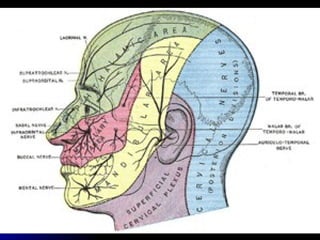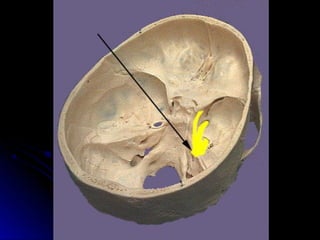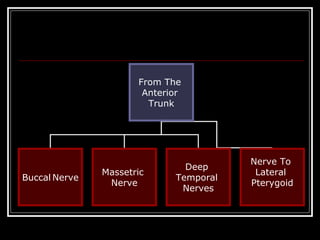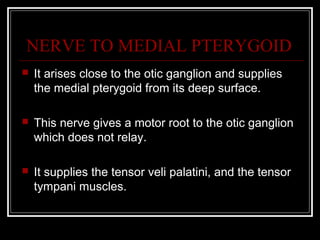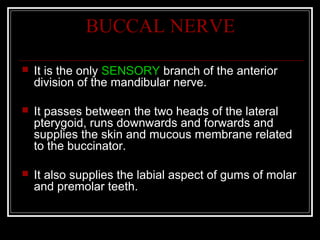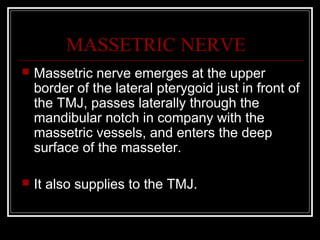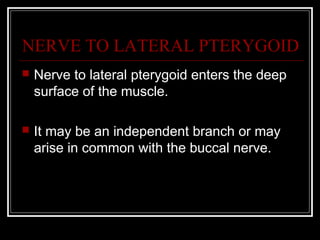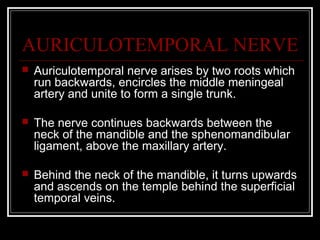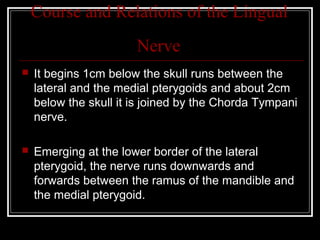Trigeminal Nerve (Mandibular Division) Introduction
- 1. Trigeminal Nerve (Mandibular Nerve division) By- Dr. AVIRAL VERMA
- 2. Trigeminal Nerve The fifth cranial nerve or the trigeminal nerve, emerges from the side of the pons and has a large sensory root and a small motor root. The roots cross the apex of the petrous temporal bone beneath the superior petrosal sinus, to enter the middle cranial fossa. Chief sensory nerve for the face and head has sensations of pain, temperature and touch. Motor action on muscles of mastication.
- 3. Branches of the Trigeminal Nerve Three main branches- The ophthalmic branch – sensory – lacrimal glands, conjunctiva, forehead, eyelids, anterior aspect of scalp and the mucous membrane of the nose The maxillary branch – sensory – cheeks, upper gums, upper teeth aned lower eyelids The mandibular branch sensory and motor – teeth and gums of the lower jaw, pinnas lower lip and tongue – muscles of mastication
- 8. Mandibular Nerve This is the largest of the three divisions of the trigeminal nerve also known as n. mandibularis; inferior maxillary nerve. It has both sensory and motor fibers and supplies the teeth and gums of the mandible, the skin of the temporal region, the auricula, the lower lip, the lower part of the face, and the muscles of mastication; it also supplies the mucous membrane of the anterior two-thirds of the tongue It is the nerve of the first brachial arch and supplies all structures derived from the mandibular or first brachial arch.
- 9. Course and Relations of the Mandibular Nerve Mandibular nerve begins in the middle cranial fossa through a large sensory root and small motor root. The sensory root arises from the lateral part of the trigeminal ganglion and leaves the cranial cavity through Foramen Ovale. The motor lies deep to the trigeminal ganglion and to the sensory root. It also passes through the foramen ovale to join the sensory root just below the foramen thus forming the main trunk which passes through the infratemporal fossa. After a short course, the main trunk divides into a small anterior trunk and a large posterior trunk.
- 13. Branches Of The Mandibular Nerve Main Trunk Meningeal Branch Nerve to medial pterygoid
- 14. From The Anterior Trunk Nerve To Deep Massetric Lateral Buccal Nerve Temporal Nerve Pterygoid Nerves
- 15. From The Posterior Trunk Auriculotemporal Inferior Alveolar Lingual Nerve Nerve Nerve
- 16. MENINGEAL BRANCH Also known as Nervus Spinosus. It enters the skull through Foramen Spinosum with the middle meningeal artery. It supplies dura mater of the middle cranial fossa.
- 17. NERVE TO MEDIAL PTERYGOID It arises close to the otic ganglion and supplies the medial pterygoid from its deep surface. This nerve gives a motor root to the otic ganglion which does not relay. It supplies the tensor veli palatini, and the tensor tympani muscles.
- 19. BUCCAL NERVE It is the only SENSORY branch of the anterior division of the mandibular nerve. It passes between the two heads of the lateral pterygoid, runs downwards and forwards and supplies the skin and mucous membrane related to the buccinator. It also supplies the labial aspect of gums of molar and premolar teeth.
- 20. MASSETRIC NERVE Massetric nerve emerges at the upper border of the lateral pterygoid just in front of the TMJ, passes laterally through the mandibular notch in company with the massetric vessels, and enters the deep surface of the masseter. It also supplies to the TMJ.
- 21. DEEP TEMPORAL NERVES Deep Temporal Nerves are two in number, the anterior and the posterior nerves. They pass between the skull and the lateral pterygoid, and enters the deep surface of the temporalis. The anterior nerve is often a branch of the buccal nerve and posterior nerve may arise in common with the massetric nerve.
- 22. NERVE TO LATERAL PTERYGOID Nerve to lateral pterygoid enters the deep surface of the muscle. It may be an independent branch or may arise in common with the buccal nerve.
- 24. AURICULOTEMPORAL NERVE Auriculotemporal nerve arises by two roots which run backwards, encircles the middle meningeal artery and unite to form a single trunk. The nerve continues backwards between the neck of the mandible and the sphenomandibular ligament, above the maxillary artery. Behind the neck of the mandible, it turns upwards and ascends on the temple behind the superficial temporal veins.
- 25. LINGUAL NERVE Lingual nerve is one of the terminal branches of the posterior division of the mandibular nerve. It is sensory to the anterior 2/3rd of the tongue and to the floor of the mouth.
- 26. Course and Relations of the Lingual Nerve It begins 1cm below the skull runs between the lateral and the medial pterygoids and about 2cm below the skull it is joined by the Chorda Tympani nerve. Emerging at the lower border of the lateral pterygoid, the nerve runs downwards and forwards between the ramus of the mandible and the medial pterygoid.
- 27. Next it lies in direct contact with the mandible, medial to the third molar between the origins of the superior constrictor and the mylohyoid muscles. It leaves the gums, runs over the hyoglossus deep to the mylohyoid and round the submandibular duct dividing into terminal branches.
- 29. INFERIOR ALVEOLAR NERVE Inferior Alveolar Nerve is the largest terminal branch of the posterior division of the mandibular nerve. It runs vertically downwards lateral to the medial pterygoid and to the sphenomandibular ligament. It enters the mandibular foramen and runs in the mandibular canal accompanied by the inferior alveolar artery.
- 30. Branches of the Inferior Alveolar Nerve The MYLOHYOID BRANCH contains all motor fibers of the posterior division. It arises just before the inferior alveolar nerve enters the mandibular foramen, pierces the sphenomandibular ligament with the mylohyoid artery and supplies the mylohyoid muscle and the anterior belly of the digastric. While running in the mandibular canal the inferior alveolar nerve gives branches supplying the lower teeth and the gums.
- 31. The MENTAL NERVE emerges at the mental foramen and supplies the skin of the chin, skin and the mucous membrane of the lower lip. Its incisive branch supplies the labial aspect of the gums of canine and incisor teeth.
- 32. THANKYOU…





